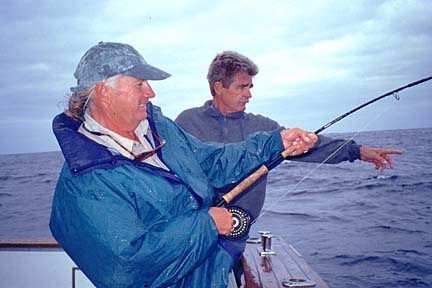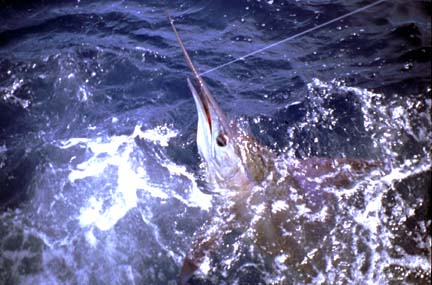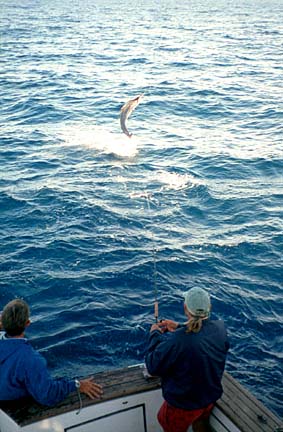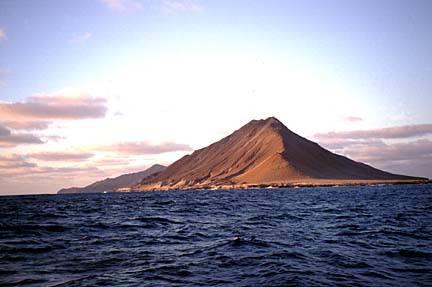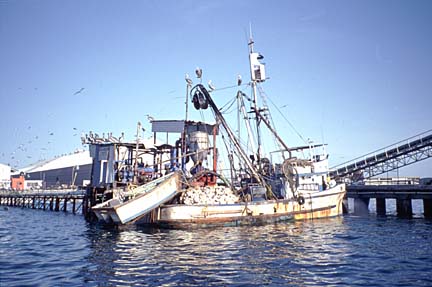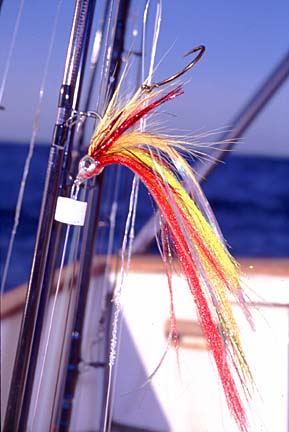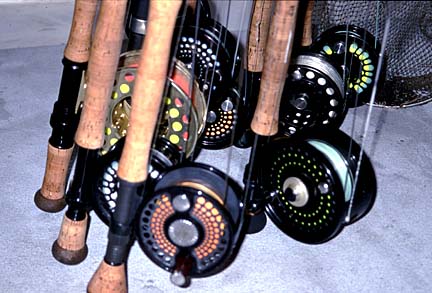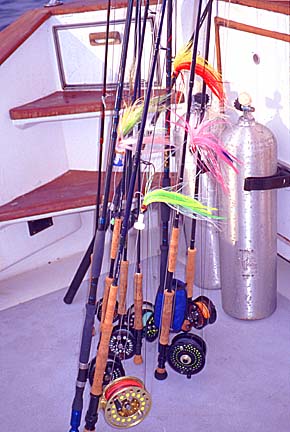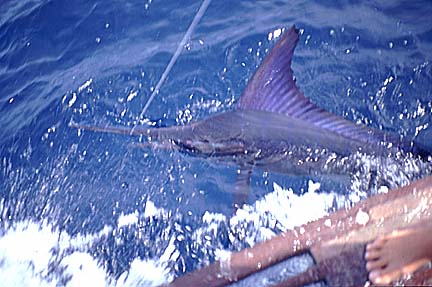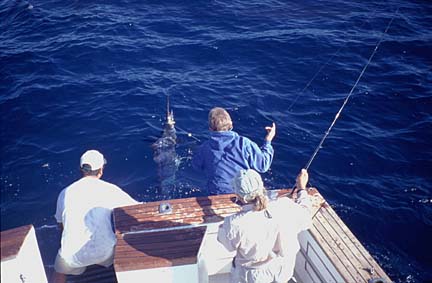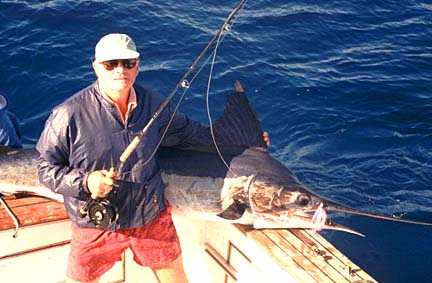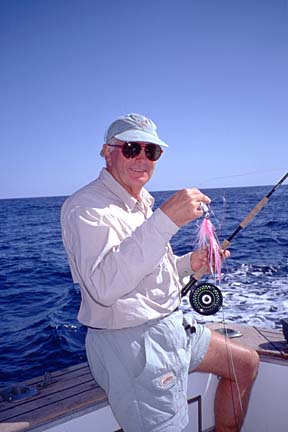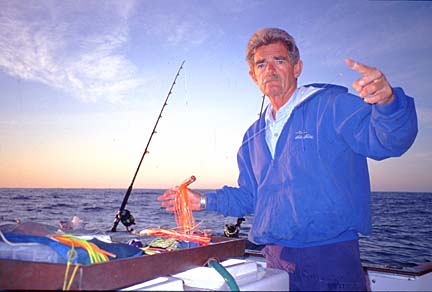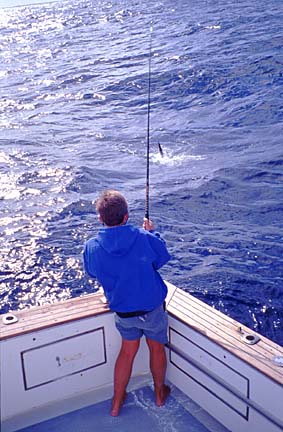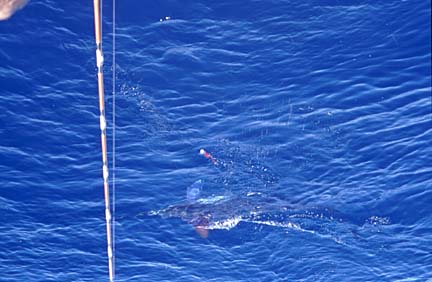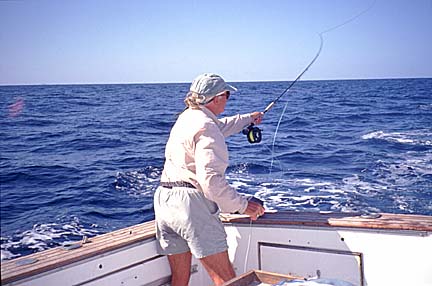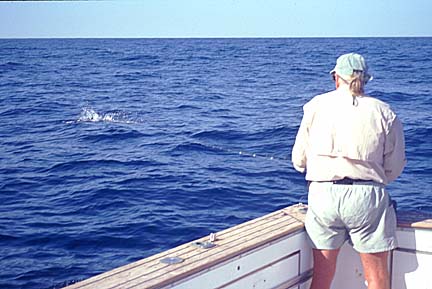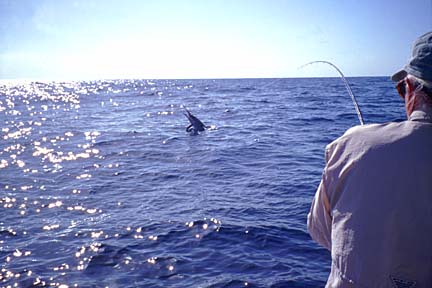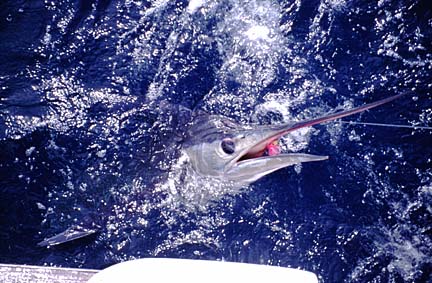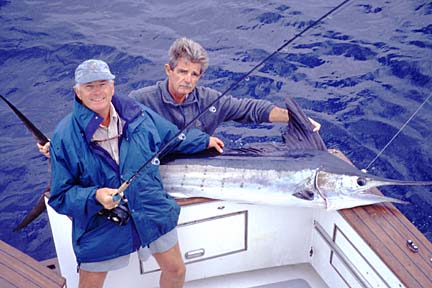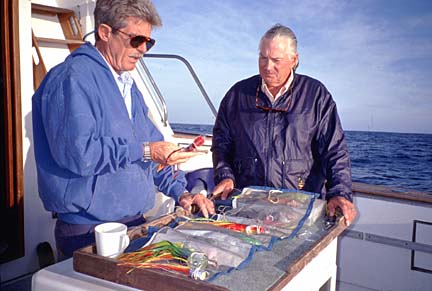
Gary Graham: Baja's Master Matador of Marlin on the Fly
![]()
BAJA CALIFORNIA: OFFSHORE FLY FISHING FOR MARLIN AT THE THETIS BANK
|
Gary Graham of Baja On The Fly with client Ray Barker Smith, left, on a Thetis Bank striped marlin. |
Dec. 1999, by Gene Kira, Western Outdoor News:
By the afternoon of the fifth day of fly fishing at Magdalena Bay, Baja California Sur, Mexico, Gary Graham had the marlin spinning in circles and biting at their own tails. And that night--as we lay at anchorage in Bahia Santa Maria--we knew that we had seen something special, something significant that raised the bar a notch or two for hooking striped marlin on the fly.
The numbers had been the stuff that dreams are made of. In five days of fishing, we had raised a very conservatively estimated 150--to well over 200--striped marlin to the teasers. The exact count depended on how you wanted to "count" them. With ten to twenty marlin showing color under the boat, which do you count as "on the teasers," and which were just waiting in line? On our best day, we raised well over fifty fish. On our "slowest" day, we raised sixteen, cast to eight, hooked four, and landed two, in a perfect series of 50 percent ratios.
|
|
We had found these "stripers" during the first week of December, in a slowly moving zone measuring about eight miles wide by three miles north-and-south, centered eighteen miles off Baja California's Pacific coast at Magdalena Bay. This is the spot known as the "Thetis Bank," which surrounds a six-fathom high point at the south end of a favorite fishing area along the edge of the continental shelf called "The Ridge" by Southern California long-range boat skippers.
For five days, we fished this highly productive, sharply defined zone of life, trolling teasers and casting tandem-hooked streamers to an almost continuous procession of striped marlin raised to the boat in a wondrous display of how rich the sea can be, and we used this opportunity of a lifetime to hone our teasing and hooking skills much faster than I would have imagined possible.
In 35 years of fishing both coasts of Baja California, I had never witnessed anything to equal it. The only written account of a comparable fish "pileup" that I had ever read was in a 1956 article by famed Baja writer, Ray Cannon, in which he described a wild scene north of Isla Tiburon of the Sea of Cortez. Cannon wrote of the billfish, dorado and other species present: "we could see them leaping clear of the surface as far as we could see water--and in all directions."
On our peak afternoon at the Thetis Bank, we also, were literally surrounded by schools of jumping marlin, spaced about a quarter-mile apart, all of them visible simultaneously, in a grid that also stretched over the horizon "in all directions." Each continuously splashing school was marked by hundreds of diving frigate birds and jumping sea lions and porpoise that had joined the marlin to feed on shoals of sardines.
|
A Thetis Bank marlin feels the hook set, left. At right, Punta Hughes, at the entrance to Magdalena Bay. Below, Seiners unload at the commercial dock at San Carlos. At right, a successful marlin fly. |
This otherworldly scene presented itself not sporadically, but continuously and unrelentingly through the afternoon. The marlin--with their tails beating wildly--accelerated into our pattern of teasers so often that my world-traveling fishing partner, Ray Barker-Smith, of England, stood transfixed, pinned to the transom, with his 14-weight Orvis rod either in use or held at the ready, for eight hours and twenty-five minutes without sitting, eating, or taking a rest break; he had never seen anything like it either.
Ray and I were fortunate to have as our professional guide for this adventure, Gary Graham, a legend in Southern California sport fishing circles, who today owns and operates the highly successful East Cape fly fishing service, Baja On The Fly, together with his wife Yvonne Graham.
For this trip, Gary had specially chartered the 48-foot sportfisher, Garota, out of La Paz, and he had ordered the boat brought around the tip of Baja California and up the Pacific coast to Magdalena Bay. We would fish the Thetis Bank with only two anglers aboard--one left-handed and the other right-handed--and our purpose was to test some of Gary's new marlin teasing techniques, which he had formulated as a result of three decades of heavy billfish experience on both conventional and fly tackle.
|
About $10,000 worth of fly tackle, total weight, about 10 pounds. |
To conduct these tests successfully, we needed a lot of "volunteer" marlin to use as "subjects," and the Garota's long ride--around Cabo San Lucas and another 150-odd miles north--was timed to coincide with the annual late fall Thetis Bank fish pileup, which Gary had been tracking for twenty years, ever since 1979 when he and Yvonne accidentally bumped into it while ferrying a yacht from Cabo San Lucas to San Diego.
With Gary's laptop computer installed on the Garota's bridge--running Nobeltech navigation software and crammed with many seasons' worth of dates, water temperatures, fish counts, and coordinates--we settled into our anchorage at Bahia Santa Maria and prepared ourselves for what we hoped would be a five-day rendezvous with some of the best billfish "testing" of our lives.
But our hearts dropped the first morning out as we began the 18-mile run to the area of highest probability, and the sunrise revealed a green and lifeless sea, completely devoid of fish signs, with an empty horizon ahead that showed not a single bird flying anywhere. One after another, we trolled through our near shore "numbers" with lures out, and we saw and caught nothing, not even a skipjack.
Then we approached the Thetis Bank itself, and we crossed into the invisible plume of nutrients flowing slowly south from it in the California Current--much like smoke streaming downwind from an underwater chimney. It was as though we had opened a cattle gate and entered a crowded feed lot. In less than two miles of trolling, the sky around us became suddenly filled with multiple clusters of frigate birds, visible through Gary's cocker spaniel-sized pair of Zeiss binoculars, and the sea beneath each assemblage was spangled with the quick white splashes of jumping fish.
|
|
The first two marlin crashed the pattern just as we reached the nearest group of birds, and for the next five days we returned again and again to this tightly fenced Thetis Bank "feed lot," whose massive concentration and volume of billfish allowed us to experiment with Gary's teasing, stripping, and hook-setting techniques, and to get a good feel for exactly when and where to present the fly.
By teasing to within a few feet of the boat--either in the wake or just outside of it--and by casting to different locations around the fish, we gradually learned how to optimize our chances for a hookup in the corner of its mouth. We learned how to make the marlin snap into a tight circle--just as a bullfighter does with a bull--and time-after-time we were able to force the marlin to hit a fly swimming crosswise to its bill. It was a lifetime of experience and learning in less than a week, and with these new techniques our success ratio eventually exceeded 50 percent.
As fly anglers, Ray and I made very quick progress on hooking billfish properly because of Gary's coaching and his ability to adapt quickly to what was observed on the previous fish. We also benefited from our perfect timing to intercept the Thetis Bank fall fish pileup, which resulted in our having huge quantities of marlin to work with, and finally from the fact that we had only two anglers on the boat.
An unusual aspect of our Thetis Bank trip was that in nearly a week of fishing, we caught absolutely nothing but striped marlin. Usually, dorado, tuna and wahoo enter the mix, and Gary's fall program--running from October through January--also includes optional side trips to the mangrove lagoons of Magdalena Bay for snook, bonefish, halibut, grouper, jacks, and a host of miscellaneous species. But, it was marlin that we had come for, and this fish, the Thetis Bank, and Gary Graham had come through in the most spectacular fashion imaginable.
|
Gary Graham (center & right) of Baja On The Fly expertly teases a striped marlin to the swim step with a hookless fly. At left, Ray Barker-Smith waits, ready to cast at a moment's notice when a marlin charges the teasers. |
EXPERT TECHNIQUES FOR HOOKING MARLIN ON THE FLY
The following revolutionary techniques will result in a very high percentage of solid hookups when fly casting for marlin. They were developed by Gary Graham during his visits to the fantastic fall fish pileup at the Thetis Bank, 18 miles off Bahia Magdalena.
1. Flies and teasers should be about seven inches long, and they should have an in-the-water body depth of about an inch-and-a-half. Flies less than an inch deep attract attention poorly, even at close range. This size preference is comparable to those established for live baits on the Sea Of Cortez by Ray Cannon in the 1960s, and for artificial lures in Baja California by Neil Kelly in the 1980s.
2. Bright colors work best. Lure silhouette--and proper and timely presentation--are more important than specific color, as long as the color is bright: white, yellow, red, orange, lime green, pink, etc., with a bit of flash.
3. Flies should be tied in tandem hook streamer patterns, with the hooks set at 90-degree angles to each other. One hook should point downwards. The other hook should point either left or right, depending on whether the angler is left-handed or right-handed. Looking at the lure, with its front pointing toward you and the hooks at the farther end, the sideways facing hook should point to the side opposite the angler's casting arm. That is, if you are right-handed, the hook should point to the left. (The reason for this is explained below.)
4. The angler must be capable of an accurate and perfectly timed cast--Hemingway's "grace under pressure"--with a relatively heavy fly, a 500-grain shooting head, and a 12-weight to 16-weight rod. However, the cast need not be long, about 25-feet is all that is necessary. More than that will actually reduce your hookup ratio (explained below.)
5. Popper heads are no good. Leave them off. There are three reasons for this. First, the buoyancy of a popper counteracts the sinking effect of your shooting head. Your fly must sink below the bubbles to the eye level of the attacking marlin--about 12 inches under the surface--at the instant it hits the water. A popper head makes this more difficult. Second, when casting to billfish from a dead or sliding boat, there isn't enough lure speed to activate the popper head's main functions: to create a "smoke" trail of bubbles behind the fly, or, to make it "pop" on the surface. Third, when mending a fly around the backside of an attacking marlin (also explained below), the water resistance of a popper head pulls the flyline straight, eliminating the desired curve.
6. The proper teasing procedure is for the angler to stand at the corner of the transom, facing sternwards, with the casting arm to the outside of the boat, i.e., a right-handed caster stands at the portside corner of the transom. About 40 feet of line is kept in a stripping bucket, and the fly is held ready in the non-casting hand. A big, noisy teaser is pulled up the middle of the white water, on the second wave, perhaps 15 feet back from the center of the transom. A second teaser is pulled on the side of the boat opposite the angler. This teaser is positioned farther back, on the fourth wave, perhaps 30 feet, and it is kept at the edge of the wake, just a few inches into the clear water. The lines of both teasers are passed through Aftco roller clips tied out a few inches from the transom. This keeps the teasers in the water, and the rollers allow quick and easy adjustment of the teasers' distance from the boat.
|
Stripping through working birds, left, and a heart-stopping sight as a marlin accelerates toward the fly; A near miss inches from the swim step, and a big cast across the transom at the critical moment; A strip strike 20 feet from the boat, and a marlin comes out for its first jump; A quick photo before the release. |
7. When a marlin accelerates into the pattern, it will usually attack the long teaser, which should be pulled by a medium-weight casting rod or "jig stick" (not a trolling rod) equipped with a gimbal butt, so it can be held securely in a rod holder. At the moment a fish enters the pattern, the short teaser must be instantly pulled out of the water, even if there is a fish on it. The long teaser must be expertly reeled toward the boat, keeping it just a few inches away from the marlin's bill. It may be necessary to reel very rapidly, or pause, or even drop back temporarily, depending on the actions of the fish. The object is to lead the fish right to the corner of the transom opposite the angler.
8. The boat should not be accelerated, slowed, or turned during the tease. Steady and straight ahead works best.
9. Eventually, the marlin should come to within a few feet of the boat, with its bill practically beating on the swim step. At this point, the teaser has been reeled right to the rod tip. The person doing the teasing shouts for the boat to be put into neutral, and for the caster to present the fly.
10. Simultaneously, the teaser is swept entirely out of the water, and it is held ready to cast if necessary.
|
|
11. With as little delay as possible, the fly is cast across the wake, into a ten-foot-wide lane of clear water just on the far side of the bubbles. The fly should not be cast more than ten feet outside the far corner of the transom.
12. Immediately, the angler should mend the flyline in a curve away from the boat and around the back of the fish, and begin stripping briskly.
13. The marlin, anxious to relocate the teaser, almost invariably makes a violent, sharp turn away from the boat and away from the blinding effect of the bubbly wake.
14. The fly accelerates toward the angler and back through the wake, due to the curve of the mended line, the angler's stripping, and the residual movement of the sliding boat. It passes directly through the turning marlin's field of vision.
15. The marlin strikes the fly, usually while traveling directly away from the boat, but sometimes after making a 270-degree turn and heading parallel to the transom, right across the stern! (This can be unnerving when the fish leaps into the air and hits the fly only inches from the swim step.)
16. The sideways facing hook, as long as it is facing the "inside" of the turn, hooks the marlin in the corner of its mouth. This hook location will be on the right side of the fly (looking at it from the front) for a left-handed angler, and on the left side of the fly for a right-handed angler. Therefore, two types of flies must be tied, depending on whether the angler is left or right-handed.
17. In no case should the fly be cast more than ten feet outside of the boat's wake. This limits visibility and puts the fly in dead water on the outside of the marlin's turn. The marlin is much more likely to strike if the fly is between it and the bubbly wake.
18. If the marlin does not strike, the fly is immediately stripped back to casting position while the boat gets underway again and the teaser is repeatedly cast out to the clear water on the side opposite the angler. Often, this will raise the same fish, or another fish, within a few seconds.
19. Fly reel backing should be plain old 30-pound dacron, which forms a forgiving bow in the line during the fight. This "stretch" helps to protect the class tippet if the fish snaps its head suddenly or jumps and lands on the line. Braided Spectra "super-line" backing cuts through the water too easily, reducing the bowing effect and protection for the class tippet.
|
Gary Graham, left, with expert fly angler, Ray Barker-Smith of the U.K. |
BAJA ON THE FLY
Gary and Yvonne Graham's fly fishing guide service, Baja On The Fly, is based in the charming Mexican twin-village of Los Barriles/Buena Vista, in Baja's East Cape Area, at the south end of the Sea of Cortez. This location was chosen with great care, because of its world class mix of inshore and offshore fish species, and because it is only a long shuttle taxi ride from Los Cabos International Airport, which also serves Cabo San Lucas.
Baja On The Fly is an Orvis-endorsed operation that features beach fishing and offshore fishing at East Cape and La Paz, the Thetis Bank fall offshore trips, and the exciting mangrove channels of 140-mile-long Magdalena Bay on Baja's Pacific coast. Marlin, sailfish, dorado, tuna, wahoo, roosterfish, jack crevalle, and a host of reef and shallow water species are available somewhere in these areas virtually year round.
Gary is well-known in Southern California sport fishing circles as a pioneer of light tackle marlin fishing and winner of numerous awards and tournaments dating back to the early 1980s. He was the first member of the historic Tuna Club of Avalon to catch three "button fish" in his first year of membership, has set several world records, and today is a Baja, California Sur, Mexico, official representative for the International Game Fish Association (IGFA). Contact: www.bajafly.com.
(Related Baja California, Mexico, articles and reports may be found at Mexfish.com's main Baja California information page. See weekly fishing news, photos, and reports from the major sportfishing vacation areas of Mexico including the Baja California area in "Mexico Fishing News.")
MEXICO FISHING INFO BAJA FISHING INFO "WEEKLY MEXICO FISHING NEWS" FISH PHOTO GALLERY
